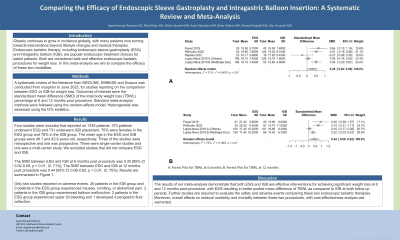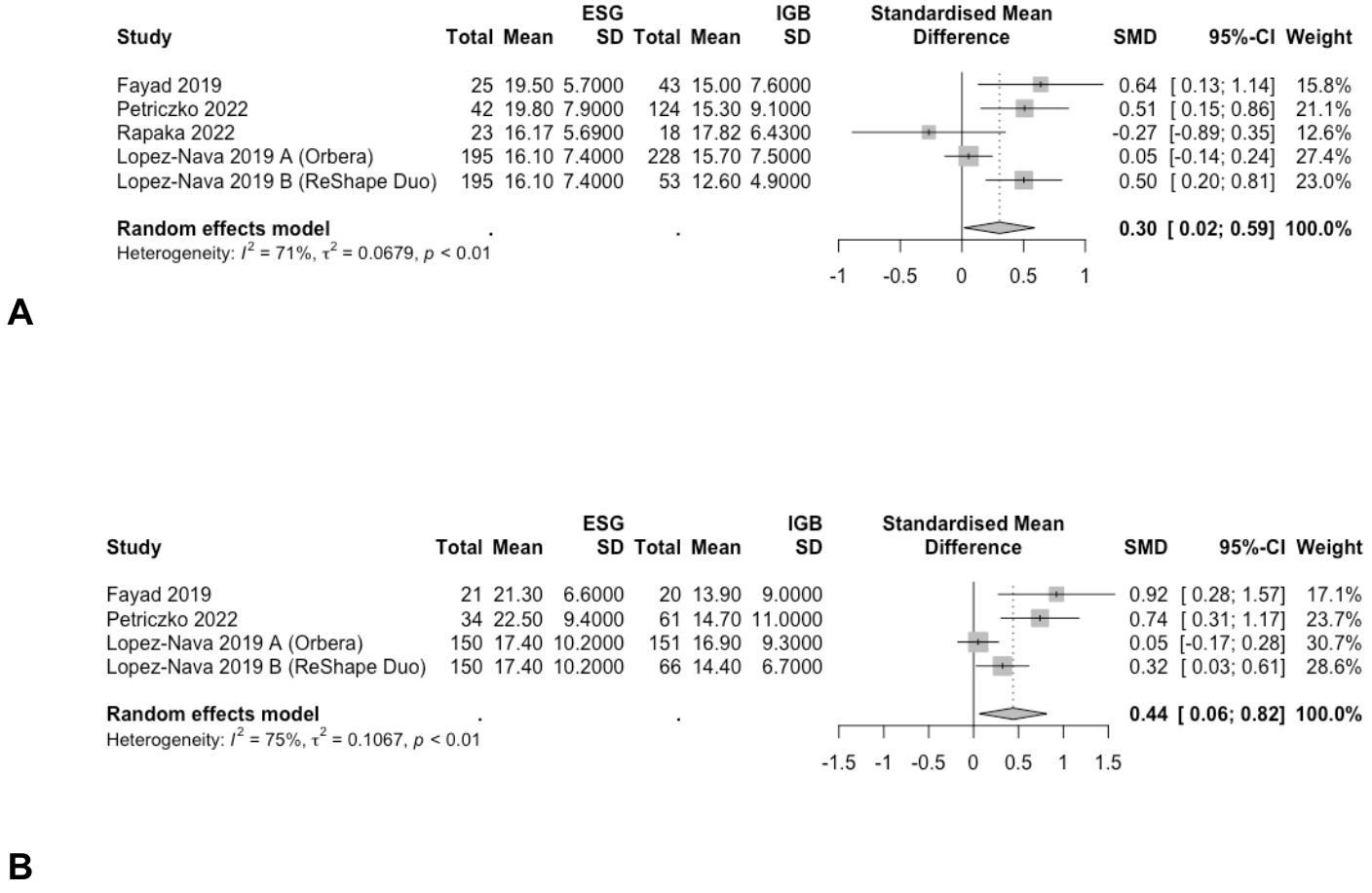Monday Poster Session
Category: Obesity
P2612 - Comparing the Efficacy of Endoscopic Sleeve Gastroplasty and Intragastric Balloon Insertion: A Systematic Review and Meta-Analysis
Monday, October 23, 2023
10:30 AM - 4:15 PM PT
Location: Exhibit Hall

Has Audio

Syed Hamaad Rahman, DO
Methodist Dallas Medical Center
Dallas, TX
Presenting Author(s)
Syed Hamaad Rahman, DO1, Nihal Ijaz Khan, MD2, Mahir Qureshi, MD3, Rami Musallam, MD4, Babu Mohan, MD, MS5, Ahmed Alobaidi, MD1, Abu Hurairah, MD2
1Methodist Dallas Medical Center, Dallas, TX; 2AdventHealth, Orlando, FL; 3Cooper University Hospital, Philadelphia, PA; 4Case Western Reserve University School of Medicine, Cleveland, OH; 5University of Utah Health School of Medicine, Salt Lake City, UT
Introduction: Obesity continues to grow in incidence globally, with many patients now turning towards interventions beyond lifestyle changes and medical therapies. Endoscopic bariatric therapy, including endoscopic sleeve gastroplasty (ESG) and intragastric balloon (IGB), are popular endoscopic treatment choices for select patients. Both are considered safe and effective endoscopic bariatric procedures for weight loss. In this meta-analysis we aim to compare the efficacy of these two modalities.
Methods: A systematic review of the literature from MEDLINE, EMBASE and Scopus was conducted from inception to June 2023, for studies reporting on the comparison between ESG vs IGB for weight loss. Outcomes of interest were the standardized mean difference (SMD) of the total body weight loss (TBWL) percentage at 6 and 12 months post procedure. Standard meta-analysis methods were followed using the random-effects model. Heterogeneity was assessed using the I2% statistics.
Results: Four studies were included that reported on 1335 patients. 370 patients underwent ESG and 731 underwent IGB placement. 70% were females in the ESG group and 76% in the IGB group. The mean age in the ESG and IGB groups were 46.1 and 42.9 years old, respectively. Three of the studies were retrospective and one was prospective. Three were single-center studies and one was a multi-center study. We excluded studies that did not compare ESG and IGB.
The SMD between ESG and IGB at 6 months post procedure was 0.30 [95% CI 0.02-0.59, p < 0.01, I2: 71%]. The SMD between ESG and IGB at 12 months post procedure was 0.44 [95% CI 0.06-0.82, p < 0.01, I2: 75%]. Results are summarized in Figure 1.
Only two studies reported on adverse events. 25 patients in the IGB group and 0 patients in the ESG group experienced nausea, vomiting, or abdominal pain. 2 patients in the IGB group experienced balloon malfunction. 2 patients in the ESG group experienced upper GI bleeding and 1 developed a perigastric fluid collection.
Discussion: The results of our meta-analysis demonstrate that both ESG and IGB are effective interventions for achieving significant weight loss at 6 and 12 months post-procedure, with ESG resulting in better pooled mean difference of TBWL as compared to IGB at both follow up periods. Further studies are required to evaluate the safety and adverse events comparing these two endoscopic bariatric therapies. Moreover, overall effects on medical morbidity and mortality between these two procedures, with cost-effectiveness analysis are warranted.

Disclosures:
Syed Hamaad Rahman, DO1, Nihal Ijaz Khan, MD2, Mahir Qureshi, MD3, Rami Musallam, MD4, Babu Mohan, MD, MS5, Ahmed Alobaidi, MD1, Abu Hurairah, MD2. P2612 - Comparing the Efficacy of Endoscopic Sleeve Gastroplasty and Intragastric Balloon Insertion: A Systematic Review and Meta-Analysis, ACG 2023 Annual Scientific Meeting Abstracts. Vancouver, BC, Canada: American College of Gastroenterology.
1Methodist Dallas Medical Center, Dallas, TX; 2AdventHealth, Orlando, FL; 3Cooper University Hospital, Philadelphia, PA; 4Case Western Reserve University School of Medicine, Cleveland, OH; 5University of Utah Health School of Medicine, Salt Lake City, UT
Introduction: Obesity continues to grow in incidence globally, with many patients now turning towards interventions beyond lifestyle changes and medical therapies. Endoscopic bariatric therapy, including endoscopic sleeve gastroplasty (ESG) and intragastric balloon (IGB), are popular endoscopic treatment choices for select patients. Both are considered safe and effective endoscopic bariatric procedures for weight loss. In this meta-analysis we aim to compare the efficacy of these two modalities.
Methods: A systematic review of the literature from MEDLINE, EMBASE and Scopus was conducted from inception to June 2023, for studies reporting on the comparison between ESG vs IGB for weight loss. Outcomes of interest were the standardized mean difference (SMD) of the total body weight loss (TBWL) percentage at 6 and 12 months post procedure. Standard meta-analysis methods were followed using the random-effects model. Heterogeneity was assessed using the I2% statistics.
Results: Four studies were included that reported on 1335 patients. 370 patients underwent ESG and 731 underwent IGB placement. 70% were females in the ESG group and 76% in the IGB group. The mean age in the ESG and IGB groups were 46.1 and 42.9 years old, respectively. Three of the studies were retrospective and one was prospective. Three were single-center studies and one was a multi-center study. We excluded studies that did not compare ESG and IGB.
The SMD between ESG and IGB at 6 months post procedure was 0.30 [95% CI 0.02-0.59, p < 0.01, I2: 71%]. The SMD between ESG and IGB at 12 months post procedure was 0.44 [95% CI 0.06-0.82, p < 0.01, I2: 75%]. Results are summarized in Figure 1.
Only two studies reported on adverse events. 25 patients in the IGB group and 0 patients in the ESG group experienced nausea, vomiting, or abdominal pain. 2 patients in the IGB group experienced balloon malfunction. 2 patients in the ESG group experienced upper GI bleeding and 1 developed a perigastric fluid collection.
Discussion: The results of our meta-analysis demonstrate that both ESG and IGB are effective interventions for achieving significant weight loss at 6 and 12 months post-procedure, with ESG resulting in better pooled mean difference of TBWL as compared to IGB at both follow up periods. Further studies are required to evaluate the safety and adverse events comparing these two endoscopic bariatric therapies. Moreover, overall effects on medical morbidity and mortality between these two procedures, with cost-effectiveness analysis are warranted.

Figure: A: Forest Plot for TBWL at 6 months
B: Forest Plot for TBWL at 12 months
B: Forest Plot for TBWL at 12 months
Disclosures:
Syed Hamaad Rahman indicated no relevant financial relationships.
Nihal Ijaz Khan indicated no relevant financial relationships.
Mahir Qureshi indicated no relevant financial relationships.
Rami Musallam indicated no relevant financial relationships.
Babu Mohan indicated no relevant financial relationships.
Ahmed Alobaidi indicated no relevant financial relationships.
Abu Hurairah indicated no relevant financial relationships.
Syed Hamaad Rahman, DO1, Nihal Ijaz Khan, MD2, Mahir Qureshi, MD3, Rami Musallam, MD4, Babu Mohan, MD, MS5, Ahmed Alobaidi, MD1, Abu Hurairah, MD2. P2612 - Comparing the Efficacy of Endoscopic Sleeve Gastroplasty and Intragastric Balloon Insertion: A Systematic Review and Meta-Analysis, ACG 2023 Annual Scientific Meeting Abstracts. Vancouver, BC, Canada: American College of Gastroenterology.

